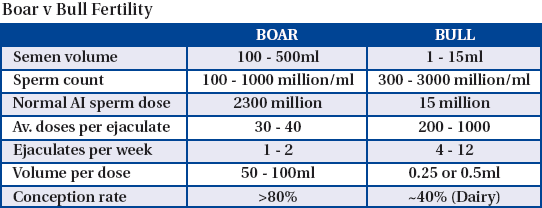



Comparative AI in pigs and cattle
By Stuart Revell - Senior Veterinary Surgeon (Research) Genus/ABS. When studying comparative reproduction in farmed mammals, they don’t come much more different than cattle and pigs. |
These differences are related to very dissimilar natural lifestyles.
Cattle are herd animals, where the principal male cannot afford to spend too long mating each individual as he has to keep rivals away, and numerous, small ejaculates are the order of the day.
Pigs are more solitary woodland animals who are not pushed for time, so copulation can be prolonged and a very high volume ejaculate produced. Herd females, constantly on the move, can cope with no more than one or two offspring, whereas a sow with a well-chosen den can cope with more, less immediately mobile, young.
The bovine lifestyle has a number of advantages for AI. The volume of the ejaculate is low, but the sperm count is high, because the cow’s cervix presents a barrier to the male. Most sperm never make it through the cervix, but AI technicians can deposit semen in the uterus, thus stealing a march on nature and allowing a very low sperm dose to be used.
In pigs, the boar’s penis locks into the sow’s cervix, so ejaculation is into the uterus. Pig AI equipment gets no further into the female than the boar does, so the sperm dose and volume used must be closer to those of natural service. Boar semen collection and processing is a lot of work in relation to the reward.
The bovine advantages continue when freezing is considered. Bull sperm are resistant to the many stresses of freezing and thawing, and frozen semen can be as fertile as fresh. Boar sperm are much more sensitive, which greatly limits the usefulness of freezing and makes the process more complex.
However, cattle don’t have it all their own way. Dairy farmers turn envious eyes on the conception rates routinely achieved in pigs, and oestrus closely tied to a clearly defined event like weaning also has its attractions.
 |
February 2007


